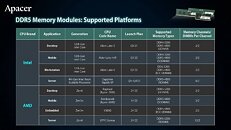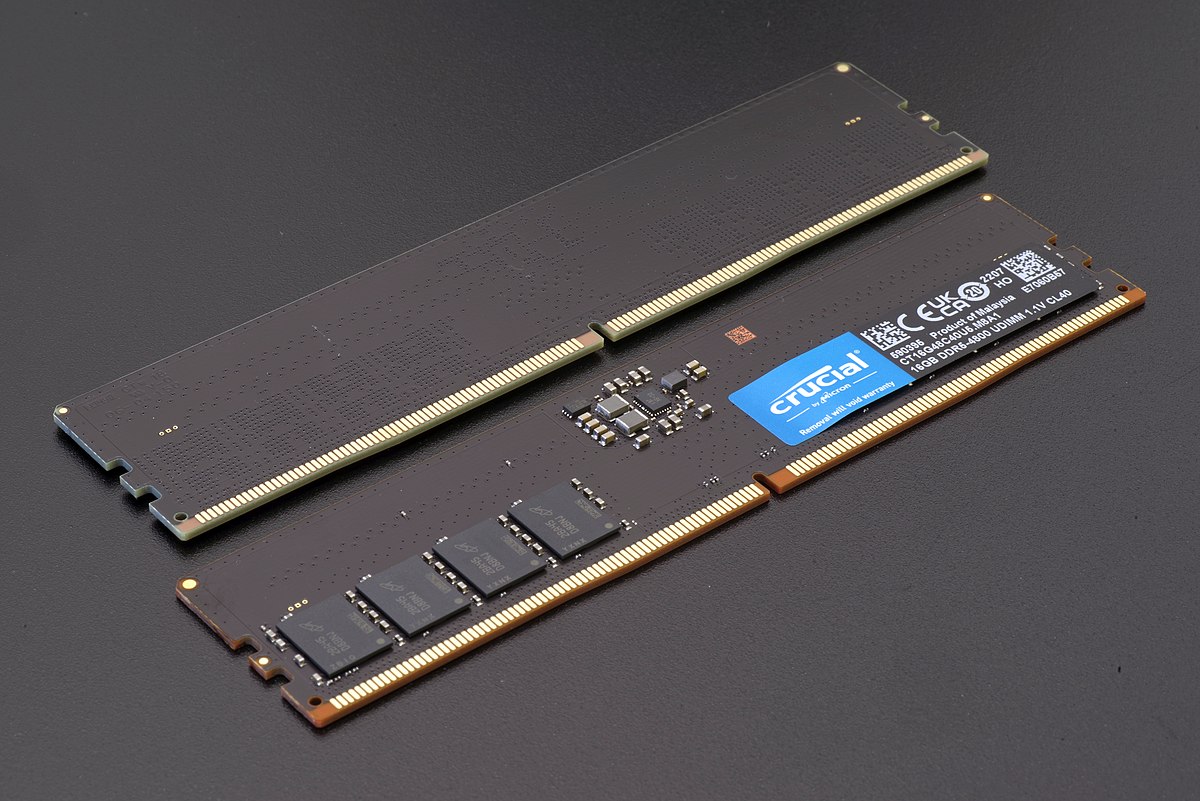- Joined
- Oct 9, 2007
- Messages
- 47,895 (7.38/day)
- Location
- Dublin, Ireland
| System Name | RBMK-1000 |
|---|---|
| Processor | AMD Ryzen 7 5700G |
| Motherboard | Gigabyte B550 AORUS Elite V2 |
| Cooling | DeepCool Gammax L240 V2 |
| Memory | 2x 16GB DDR4-3200 |
| Video Card(s) | Galax RTX 4070 Ti EX |
| Storage | Samsung 990 1TB |
| Display(s) | BenQ 1440p 60 Hz 27-inch |
| Case | Corsair Carbide 100R |
| Audio Device(s) | ASUS SupremeFX S1220A |
| Power Supply | Cooler Master MWE Gold 650W |
| Mouse | ASUS ROG Strix Impact |
| Keyboard | Gamdias Hermes E2 |
| Software | Windows 11 Pro |
AMD's upcoming Socket AM5 Ryzen 7000-series "Raphael" desktop processors will ship with native support for DDR5-5200 memory speed, according to a marketing slide by memory maker Apacer (which also owns the overclocking memory brand ZADAK). The "Zen 4" based desktop processors will feature a dual-channel DDR5 (4 sub-channel) interface, just like the 12th Gen Core "Alder Lake," but with no backwards compatibility with DDR4.
AMD already stated that Ryzen 7000 processors have a design focus on memory overclocking capabilities, including AMD EXPO, a custom memory module SPD extension standard rivaling Intel XMP 3.0, which will come with fine-grained settings specific to the AMD memory controller architecture. Until now, AMD relied on A-XMP, a motherboard vendor-enabled feature based in the UEFI firmware setup program, which translates Intel XMP SPD profiles of memory modules into AMD-approximate settings.

The Apacer slide also confirms that EPYC "Genoa" processors will come with DDR5-5200 native support. The Socket SP5 processors feature a 12-channel DDR5 (24 sub-channel) memory interface. The already-launched Ryzen 6000 "Rembrandt" mobile processors come with dual-channel (4 sub-channel) DDR5-4800 and LPDDR5-6400 interfaces.
AMD Ryzen 7000 "Raphael" processors natively supporting DDR5-5200 means that JEDEC PC5-42600 standard memory modules will run at that speed without any settings being needed in the UEFI setup program. For higher frequencies, such as DDR5-6000, AMD will rely on EXPO-certified memory modules, or possibly A-XMP like BIOS-level translators for Intel XMP 3.0 profiles.
View at TechPowerUp Main Site | Source
AMD already stated that Ryzen 7000 processors have a design focus on memory overclocking capabilities, including AMD EXPO, a custom memory module SPD extension standard rivaling Intel XMP 3.0, which will come with fine-grained settings specific to the AMD memory controller architecture. Until now, AMD relied on A-XMP, a motherboard vendor-enabled feature based in the UEFI firmware setup program, which translates Intel XMP SPD profiles of memory modules into AMD-approximate settings.

The Apacer slide also confirms that EPYC "Genoa" processors will come with DDR5-5200 native support. The Socket SP5 processors feature a 12-channel DDR5 (24 sub-channel) memory interface. The already-launched Ryzen 6000 "Rembrandt" mobile processors come with dual-channel (4 sub-channel) DDR5-4800 and LPDDR5-6400 interfaces.
AMD Ryzen 7000 "Raphael" processors natively supporting DDR5-5200 means that JEDEC PC5-42600 standard memory modules will run at that speed without any settings being needed in the UEFI setup program. For higher frequencies, such as DDR5-6000, AMD will rely on EXPO-certified memory modules, or possibly A-XMP like BIOS-level translators for Intel XMP 3.0 profiles.
View at TechPowerUp Main Site | Source







